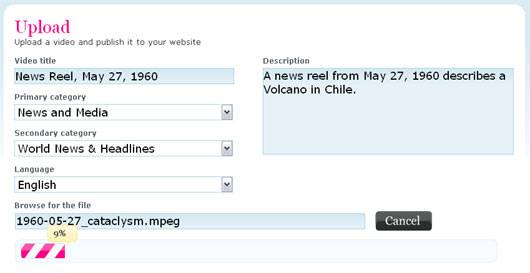Online video ad network LiveRail launched a public beta just about a month ago, and yesterday I caught up with CEO Mark Trefgarne to get an update on how things are progressing at the London-based start up. So far the company is not taking or sharing any real money, but rather just stress testing their system and working out the kinks in their video hosting platform, and targeting and ad serving technology.

So far the company has signed up around 500 publishers who are streaming about 30-40,000 video streams per day across the network. Those publishers are adding about 30-40 new videos per day to the system. These number certainly aren’t staggering, but the site is operating right now on an invite-only basis and hasn’t really begun to aggressively sign up advertisers.

Early on, LiveRail decided that the traditional pre-roll or post-roll approach to video advertising was flawed. Viewers often just skipped or ignored the advertisements while waiting for their video to play. Instead, LiveRail’s approach is something they call “click-to-play.” Advertisements are loaded along with the video in the Flash player (currently below the video window, though Trefgarne told me that they are experimenting with other placements for the ads, including a YouTube-style overlay). Ads are only played when viewers see something that interests them an click on it.
Trefgarne said that early data indicates that for some sites the conversion rate (i.e., people who click on and watch ads) is between 10-20%. The data set is small, though, and the numbers skew up and down radically at times, I was told. But, said Trefgarne, there is something of a learning curve for viewers. He told me they often notice that a web site’s click-thru rate will improve with time as users get acquainted with the idea of click-to-play ads.
Right now ads are targeted using a two part process. First they are delivered based on categories — which publishers and advertisers specify when they upload their videos to LiveRail’s servers — and second, the ads are prioritized and delivered based on bid price (per view), and popularity metrics that the company tracks like click-thru rate and how long the ad is usually viewed before users exit. In a way, said Trefgarne, users are “voting with their eyeballs” which ads are the most likely to succeed. Those with the highest chance of success are shown more often.

Advertisers are currently being charged on a strictly per view basis (or will be once the site begins accepting and doling out real money), but LiveRail hopes to experiment with different models in the future. Trefgarne told me he’d even like to try new ways of delivering the hated pre-roll advertisements that might be more effective.
On the publisher end, LiveRail acts as a host, but not a destination. LiveRail provides video hosting for publishers in exchange for serving ads on the video (of which publishers also get a cut of the revenue). This allows publishers to monetize their content while simultaneously saving money on hosting and bandwidth costs. What LiveRails doesn’t do is distribute video; that is left up to the publisher. There will be no LiveRail gallery of publisher content, which makes the company more like VideoEgg than YouTube.

In a post on Trefgarne’s blog, he muses about behavioral targeting and how it might work for video advertising. He told me that this is something LiveRail would love to do long term, but currently they are not targeting videos this way and it is not a priority. The main priority for the LiveRail team right now is releasing an API to publishers that would allow them to integrate LiveRail ads into an existing player, and closing a round of venture funding. Both could happen within the next 6-8 weeks.
Despite the name, LiveRail is built using PHP and utilizes Amazon’s S3 web service for storage of videos. Trafgarne said Amazon has saved them a lot of money in hosting costs and that it has handled traffic spikes beautifully so far. He told me that though the load right now isn’t particularly high, Amazon’s service handled a publisher video being featured on the main page of the Fox News website without missing a beat.
Video advertising is still in its infancy on the Internet and LiveRail seems especially open to experimentation, which I think is good. To win in this area companies will need to stay agile as they struggle over the next few years to figure out what type of ad delivery works best. I’ve embedded a sample video with LiveRail ads below.

















